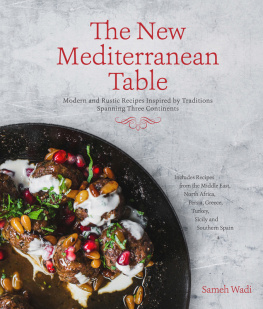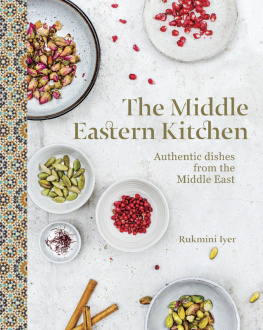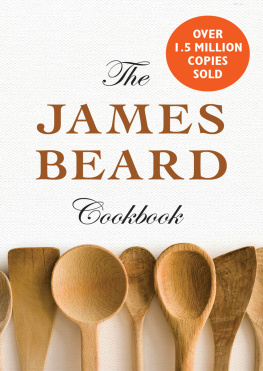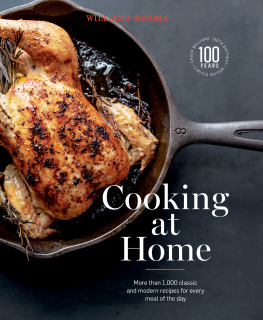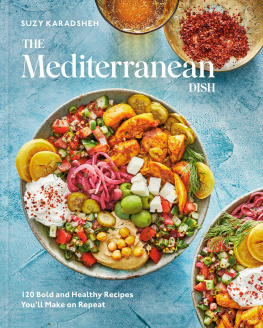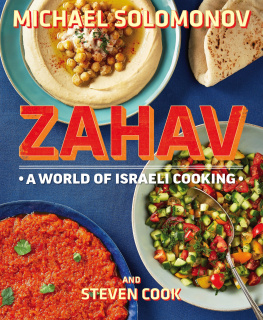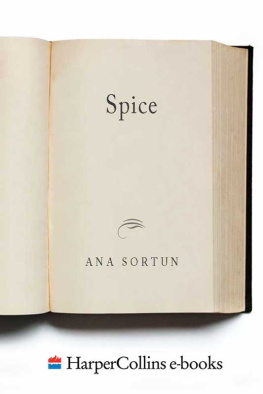The New
Mediterranean
Table
Modern and Rustic Recipes Inspired by Cooking Traditions Spanning Three Continents

Sameh Wadi
Chef/owner of the critically acclaimed and award-winning
Saffron Restaurant and Lounge in Minneapolis

The author and publisher have provided this e-book to you for your personal use only. You may not make this e-book publicly available in any way. Copyright infringement is against the law. If you believe the copy of this e-book you are reading infringes on the authors copyright, please notify the publisher at: http://us.macmillanusa.com/piracy.

To My Father
In my heart and mind you are still here, guiding and pushing me to be audacious. I hope to continue your legacy. You are my idol.
To My Mother
Your passion and adoration have been continually motivating, inspiring me to become a better person and chef. I love you more than I can express here.





ABOUT THE BOOK
This book is for anyone who is interested in exploring the rich culinary tradition of the Mediterranean and learning recipes and techniques to make it their own. It is a journey beyond run-of-the-mill recipes. It is a mixture of quick, simple and easy-to-reproduce dishes with basic ingredients and more labor-intensive ones that require patience and practice. It is a perfect balance between recipes for intermediate and avid cooks. Some of these recipes are dishes that were inspired by food from my childhood; some are dishes that I have served or still serve at my restaurant, Saffron; others are riffs on classic dishes that I love.
The book is organized by chapters that flow as a typical meal would in the Mediterranean, from small platesmezze or pre-appetizersto appetizers and salads to main courses and side dishes, finishing with desserts and drinks. Many recipes have stories; I have included some of those throughout the book. Some are reflections on memories and associated emotions from my childhood, while others offer a glimpse into the mind of a chef.
In honor of the old-world tradition of making everything from scratch, I have included some basic pantry recipes that range from preserving and pickling to making your own yogurt and cheese. While I understand that not everyone has the time to preserve their own lemons, make their own sausage and blend spices, I have included these recipes for the adventurous.
Finally, I had a difficult time deciding which recipes to include in this book. And actually, the hardest part was formulating the recipes themselves. For the most part, when I cook I rely on memory and taste rather than formulas and ratios. Spice blends and baking are the exceptions. I believe that cooking is about trial and error. It is about learning from the mistakes that you make and adjusting. So, as you journey through this cookbook, use these recipes as guidelines. Explore, experiment and create your own interpretations. Add and subtract ingredients to make the dishes your own. Challenge yourself with unfamiliar ingredients, techniques and flavors. Enjoy the taste and aroma of the food as you cook. In the end, while I hope you learn something from these pages, I also hope you fall in love with these flavors as well as the romance and tradition of this amazing cuisine.
WEIGHT AND MEASURING
I rarely measure anything when cooking. When I do, it is by weightgrams, to be exact. It is much more precise, especially when measuring spices and ingredients for baking. I have included both volume (tablespoons and cups) and metric weight and volume (grams and milliliters). I would recommend that you ultimately invest in a scale that reads to single decimals and to exclusively measure spices by weight rather than volume.
INGREDIENTS
As a rule, buy the best-quality ingredientsfrom spices and vinegar to produce and meatthat you can afford. It will make a difference in the final dishes.
Use neutral oils (grapeseed or canola) with a high smoking point when high-heat cooking. Use extra virgin olive oil for finishing and flavoring. Olive oil refers to pure or a blend of refined olive oil with virgin olive oil.
When a recipe calls for sea salt, it means fine sea salt. For kosher salt, I prefer Diamond Crystal. For a crunchy finishing salt, I like to use Maldon because of the large flakes. The majority of the spices throughout are whole, freshly toasted and ground. Spice blends are kept in airtight containers, away from heat, moisture and strong smells.


My roots are Mediterranean, influencing my love and appreciation for its cuisine. It is food that expresses the spirit of my ancestors. I have embraced its rich ingredients and traditional techniques, and it has shaped my philosophy about food. The cuisine is about coaxing complex flavors and harmonizing ingredients to make vibrant and robust dishes. This food is to be made with passion and soul, and it is best when enjoyed with loved ones. Mediterranean cuisine connects me to my heritage and the bold essence of its culture.
Traditionally speaking, Mediterranean cuisine is the food from the cultures adjacent to the Mediterranean Sea. Although this region spans a wide variety of ethnicities, religions and climates, strong historical connections and the nomadic nature of its early inhabitants led to common elements and undertones in the foods.
For many years, the main focus of Mediterranean cuisine has been on the foods of Italy, Spain and the south of France. It wasnt until recently that a growing interest in eastern Mediterranean cuisine started to take place. In the culinary world, more chefs began to experiment with these exotic flavors and incorporate spices from the eastern Mediterranean into American and European kitchens. Simultaneously, ingredients like hummus and Greek yogurt have worked their way into Western homes.

